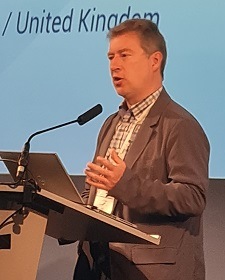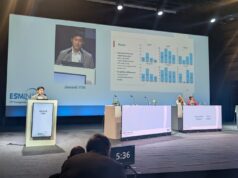
Technical and clinical outcomes associated with mechanical thrombectomy treatments in England are currently “acceptable”, but ‘drip-and-ship’ patients, process times and variation between units all represent concerns in stroke care moving forward, as per discussions at this year’s European Society of Minimally Invasive Neurological Therapy (ESMINT) congress (7–9 September, Nice, France).
These messages were delivered by Phil White (Newcastle University, Newcastle, UK), whose presentation pertained to ‘the current situation in the UK’—although the speaker prefaced his talk by noting that he would primarily be focusing on England, as the constituent parts of the UK operate independent healthcare policies and, as such, “have all approached stroke thrombectomy in a different way”.
Drawing on data from the Sentinel Stroke National Audit Programme (SSNAP), White reported that monthly thrombectomy rates have steadily increased over the past few years—largely driven by level 1a evidence favouring thrombectomy from the 2016 HERMES collaboration paper—and, after ‘flatlining’ through much of 2020 due to the COVID-19 pandemic, these numbers have picked up again recently, reaching roughly 200 procedures per month at the start of this year.
White also noted that the “main shortfall” in thrombectomy volumes across England stems from discrepancies between ischaemic stroke patients who are admitted directly to a comprehensive stroke centre (CSC), and those in drip-and-ship cohorts who are treated with intravenous thrombolysis (IVT) at a frontline hospital before being transported to a CSC, to undergo a thrombectomy.
The speaker went on to state that a theoretical maximum thrombectomy rate of 10% (across the total number of stroke admissions) has been devised, meaning roughly 8,000 eligible patients should be receiving this treatment each year in England. In reality, of those patients admitted directly to a CSC, around 6% currently undergo a thrombectomy—which White said compares reasonably with countries like Germany (8%) and Ireland (9%). However, at 3%, the national average in England is “much lower”, he continued, and, while this represents solid progress and a sixfold increase from a baseline rate of <0.5% in 2016, this average is being lowered by a “pretty miserable” 1.5% thrombectomy rate within drip-and-ship cohorts. Here, there can be significant difficulties with identifying and referring patients at primary stroke centres, he added.
White alluded to the impact of the pandemic on these figures, reporting a 28% “overnight” reduction in thrombectomy rates following the first COVID-19-related lockdown in 2020, with the “erratic and slow recovery of activity” across the UK healthcare system—but particularly within emergency and ambulance services—leading to process times being badly affected and some areas still struggling today. In addition, nearly half of all centres in England (46%) tightened their patient acceptance criteria during the pandemic, according to White, which exacerbated these effects.
Given the fairly low thrombectomy numbers seen across England, White posed the question of whether the outcomes associated with the procedures are ‘acceptable’. He asserted that, in both a clinical and a technical sense, they are, owing to reasonable levels of efficacy and procedural safety observed across real-world populations—and, although there is “probably too much variation” across the country right now, a lack of statistical outliers here suggests ‘the law of small numbers’ could be a key contributor. Touching on further real-world stroke data, White reported a median thrombolysis in cerebral infarction (TICI) 2b–3 rate of 79%, which is in line with other real-world literature, and a ‘good’ modified Rankin Scale (mRS) score (≤3) at discharge—a “reasonable but imperfect” outcome marker, according to White—of 53%, as well as 20% technical complication and 17% 30-day mortality rates, both of which are essentially in line with previous trial data.
However, regarding processes, such as ‘door-to-puncture’ and ‘door-in-door-out’ times, he said the healthcare system “can do much better”, adding that “we have gone backwards, and have not really [returned] to where we were before the pandemic”. Expanding on these process times in England, White reported that the national median door-to-puncture time is more than three hours (192 minutes) and, while this figure drops to a “more acceptable” 50 minutes in CSCs, the wide range of timings here (36–106 minutes) is less positive. The speaker went on to detail “particularly troublesome and worrying” door-in-door-out times, with a post-pandemic national median of 155 minutes (up from a pre-pandemic average of 130 minutes) that is “not going down”. He also noted that this falls short of a 90-minute interim target devised from modelling by his research group, and is “way off” the ideal target of 60 minutes that he and his collaborators have proposed.
“This really reflects things that happen outside of the CSC,” White stated. “There is some impact on door-in-door-out times, but not very much, [from] what happens in CSCs.”
White concluded by stating that “we have made modest progress in England”, and that some areas have performed better than others, with comprehensive 24/7 coverage established across Greater London, but “much lower” thrombectomy rates in other regions and potentially “unacceptable” variation between units. He also reiterated the fact that low procedure volumes, particularly in drip-and-ship patients—who are simply “not getting here [to CSCs] fast enough”—suggest system-wide issues, while process times are too long and have declined in recent years as well.
Speculating on what is driving these problems, White said: “This is multifactorial—there is inertia in our system, and it is a disruptive innovation that requires a lot of things to change. And, without upfront capital and personnel investment to facilitate development, [it will] be difficult.”
The speaker also highlighted the ongoing impact of COVID-19 on this state of affairs, before adding that “we have had a sustained lack of investment since the financial crisis of 2008, lagging well behind the [healthcare] inflation rate in terms of money being spent on the system” and, while the number of interventional neuroradiologists in England has progressed, Brexit has created “well-reported difficulties” in the recruitment and retention of EU staff.
Responding to a question from session moderator Vladimir Kalousek (Clinical Hospital Center ‘Sisters of Mercy’, Zagreb, Croatia) on UK training protocols and which physicians are allowed to perform thrombectomies, White noted that guidance published in early 2017 allows any radiologist to be trained in mechanical thrombectomy—but, nearly six years on from this, a mechanism relating to non-radiologists is yet to be fully signed off by the UK General Medical Council (GMC). White commented that, in spite of the “pressing need” here, this process has been “very slow” for a variety of reasons and, although England has doubled its number of INR trainees since 2016 and there is also a small handful of UK neurosurgeons who currently perform thrombectomies, the country is still short of interventional and general radiologists, holding one of the lowest per-person rates across Europe. “Anybody with appropriate training can do it—but the credentialing process to do it with GMC approval is still ongoing,” he added.










